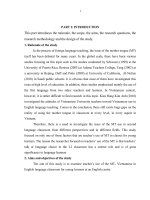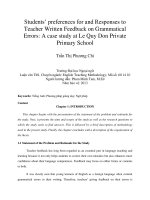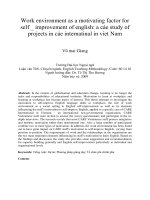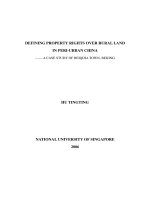Case Study: chinas mini grids for rural electrification
Bạn đang xem bản rút gọn của tài liệu. Xem và tải ngay bản đầy đủ của tài liệu tại đây (219.97 KB, 3 trang )
Low Carbon Green Growth Roadmap for Asia and the Pacific
CASE STUDY
Lighting up remote corners
China’s mini-grids for rural electrification
Key point
•
China’s rural electrification programme demonstrates that improving energy efficiency and energy
access can work in tandem with promoting the renewable industry with the right policy mix.
There was a problem…
China has been working steadily toward rural electrification for decades, with a number of government initiatives. In 2008, however, there were still an estimated two million households, or nine to ten million people, primarily
in villages and farming areas in western China, lacking electricity, according to the National Energy
Administration.1 Chinese western provinces are characterized by dispersed rural settlements. Remaining villages
without electricity are far from load centres and from existing electricity generation and transmission infrastructure.
What was done?
The Township Electrification Programme from 2001 to 2005 focused on electrifying the remote villages with a
particular emphasis on sustainability with distributed generation from renewable sources. Although renewable
energy had been a focus of the Brightness Programme since the late 1990s, the Township Electrification
Programme marked the first time that the Chinese Government focused on 100 per cent renewable energy
systems for village power. Of the 1,065 villages selected for the programme, 688 were to be electrified with
PV-battery mini-grids and 377 with small-scale hydro mini-grids.2 The most recent initiative, the Village Electrification Programme (2005–2010), looked to expand on the Township Electrification Programme’s success by electrifying 20,000 villages with renewable sources.
Results
Increased electricity access in western provinces: Through the Township Electrification Programme, 721
PV and PV or wind hybrid systems and 146 small hydropower stations were built, providing electricity to
1.3 million people.3
Electricity for basic services but not productive uses: The village power systems were built to provide
electricity for lighting and television in hopes of improving people’s quality of life and economic
development. Lighting helps young students have more time to study. However, productive uses to
generate income would demand too much capacity from the small battery system, so they were
discouraged, despite the income generation potential.4
Stimulated solar PV production: Government funding of PV-only systems for rural electrification delivered
a strong signal to the country’s domestic industry that PV is an important piece of China’s energy future.5
•
•
•
1
A. Niez, Comparative Study on Rural Electrification Policies in Emerging Economies: Keys to Successful Policies (Paris, International Energy
Agency and OECD, 2010).
2
Renewable Energy and Energy Efficiency Partnership and United Nations Industrial Development Organization, Sustainable Energy
Regulation and Policymaking Training Manual (Vienna, 2007). Available from
www.unido.org/fileadmin/media/documents/pdf/training_manual_on_sustainable_energy_regulation_and_policymaking_for_Africa.pdf
(accessed 20 October 2011).
3
Alexandra Niez, Comparative Study on Rural Electrification Policies in Emerging Economies: Keys to Successful Policies (Paris, International
Energy Agency and OECD, 2010).
4
ibid.
Low Carbon Green Growth Roadmap for Asia and the Pacific : Case Study - China’s mini-grids for rural electrification
Lessons learned
A site-specific cost-benefit analysis is required: Renewable energy-based village mini-grids were more economically viable due to the comparatively high costs of extending the transmission grid to remote, low load areas.
Other countries in the region need to assess the comparative benefits and costs of decentralized rural electrification versus grid extension; more densely populated countries or areas may find the higher-quality service from
central grid connection to be worth the investment in the grid extension.
Success factors
Public financing: The Township Electrification Programme was fully government financed, with US$293 million
coming from the central Government and US$437 million from the provincial governments. The townships
included in the programme spanned 11 provinces with different levels of development. The central Government
analysed the social and economic development of the provinces to determine the percentage of matching
funds – for example, the Government supplied 100 per cent of funding for projects in Tibet while it covered only
50 per cent of costs in Sichuan Province.6
Government-led implementing: The National Development and Reform Commission (NDRC, formerly the State
Development Planning Commission) was in charge of running the Township and Village Electrification
Programmes. Giving the top-level management to the NDRC highlighted the broader goals of the programmes,
which were to not just increase access to electricity but to reduce poverty and further other development
objectives. However, the array of government agencies involved sometimes contributed to inefficiencies.
Site assessment of energy resources: Conducting a site assessment of renewable energy resources for each
village was an important early step to designing a suitable system capable of providing reliable access to electricity to the target population. The villages in western China and islands off the eastern coast, although difficult
and expensive to reach by grid extension, are also generally rich in at least one renewable energy resource.
High solar insolation, good wind speeds and/or proximity to rivers with substantial heads were imperative enabling conditions; biomass resources could also fuel a mini-grid generator in other regions.
Preference for local production: Even in cases of bilateral partnerships with OECD countries that produce the
technology, an effort was still made to localize the manufacturing. System integrators responsible for design,
installation, operation and maintenance were selected through a competitive domestic bidding process.7
Focus on capacity building: About US$100 million of the Township Electrification Programme’s budget was dedicated to training and institutional development.8 The Government, in partnership with the US National Renewable Energy Laboratory, the German Society for Technical Cooperation (GTZ, now GIZ) and UNDP trained 135
local trainers and 115 backbone service engineers. The local trainers then prepared 1,400 village operators to
work at the township level. Due to the dispersal of the villages in the Village Electrification Programme, an additional 40,000 village operators were expected to be trained.9 In addition to operation and maintenance, operators were also trained on how to teach smart practices in electricity use to help manage power demand effectively.
5
Renewable Energy and Energy Efficiency Partnership and United Nations Industrial Development Organization, Sustainable Energy
Regulation and Policymaking Training Manual (Vienna, 2007). Available from
www.unido.org/fileadmin/media/documents/pdf/training_manual_on_sustainable_energy_regulation_and_policymaking_for_Africa.pdf
(accessed 20 October 2011).
6
ibid.
7
ibid.
8
H. Gao, Z. Wang and Y.Q. Zhao, Renewable Energy Options in Improving the Life of Western Rural Poor Population in China, in Renewable Energy Technologies (Roskilde, Denmark, Global Network on Energy for Sustainable Development, 2005). Available from
www.gnesd.org/Downloadables/RETs/ERI%20RETs%20final%20version.pdf (accessed 21 October 2011).
9 J. Ku, D. Lew and S. Ma, “Sending electricity to the townships” Renewable Energy World (2003), Sep-Oct, pp. 56-67. Available from
(accessed 25 October 2011).
Low Carbon Green Growth Roadmap for Asia and the Pacific : Case Study - China’s mini-grids for rural electrification
Considerations for replicating
Ability to pay: Although capital costs of renewable energy equipment and installation were mostly covered by
government subsidies, it was important to gauge the ability, willingness and reliability of customers to make payments to cover operational costs.
Supply and demand balancing: After estimating the overall ability to pay for electricity, an additional intricacy
was the gauging of potential levels of use at various prices per unit of electricity. Pricing too low could lead to
excessive demand, whereas pricing too high could lead to non-payment or non-use. Lack of information about
electricity supply could also lead to misuse.
Operations and maintenance know-how: Although China is a leader in renewable energy technologies, particularly PV and small hydro systems, most of the enterprises involved in those industries are based in the developed
eastern part of the country. System integrators who designed a particular mini-grid system are only responsible
for three years of operating and maintenance.10 Beyond the length of that initial contract, local technicians
capable of operating and maintaining the mini-grids to maximize efficiency would be required.
Further reading
Comparative Study on Rural Electrification Policies in Emerging Economies: Keys to Successful Policies, by Alexandra Niez, (Paris, International Energy Agency and OECD, 2010).
10
H. Gao, Z. Wang and Y.Q. Zhao, Renewable Energy Options in Improving the Life of Western Rural Poor Population in China, in Renewable Energy Technologies (Roskilde, Denmark, Global Network on Energy for Sustainable Development, 2005). Available from
www.gnesd.org/Downloadables/RETs/ERI%20RETs%20final%20version.pdf (accessed 21 October 2011).









